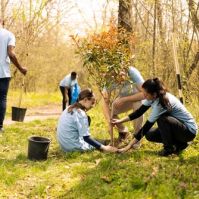 In 1970, Art Buchwald, a political satirist and humorist, said, "And Man created the plastic bag and the tin and aluminum can and the cellophane wrapper and the paper plate, and this was good because Man could then take his automobile and buy all his food in one place and He could save that which was good to eat in the refrigerator and throw away that which had no further use. And soon the earth was covered with plastic bags and aluminum cans and paper plates and disposable bottles and there was nowhere to sit down or walk, and Man shook his head and cried: 'Look at this Godawful mess.'"
In 1970, Art Buchwald, a political satirist and humorist, said, "And Man created the plastic bag and the tin and aluminum can and the cellophane wrapper and the paper plate, and this was good because Man could then take his automobile and buy all his food in one place and He could save that which was good to eat in the refrigerator and throw away that which had no further use. And soon the earth was covered with plastic bags and aluminum cans and paper plates and disposable bottles and there was nowhere to sit down or walk, and Man shook his head and cried: 'Look at this Godawful mess.'"
The following year, Greenpeace and Friends of the Earth were created. The 1970s might have really been the birth of environmentalism as we know it today. Many businesses have gone green, and a lot of people are individually recycling, but what are our churches doing? What is your church doing to be more eco-friendly in worship and service? Many denominations have asked congregations to be green and are taking steps to encourage better use of resources.
10 Things Your Congregation Can Do to Be Eco-Friendly
- Think globally, act locally. Your church may not be able to save the pandas in China, but you can consider the animals and insects in your own backyard. Many local habitats are being devastated and putting raccoons, squirrels and other small creatures out of their homes.
- Talk to your pastor and leaders about what your church is doing to reduce your impact on the environment. Are there other steps that can be taken? Many times, especially in churches, change is met with opposition. Instead of becoming divided over this issue, explain why change is so necessary.
- Take a walk around the church grounds to see the biosphere of influence you have.
- Meet with local activist groups to find out how your church can be helpful. Are there issues facing your community that you can get involved with? Talk to local environmentalists about helping biotic communities in your community. Maybe you could plant a flower garden to provide birds, butterflies and bees access to pollen.
- Take your service outside to remove the barriers between preaching and nature. Go into the community to see God's hands at work.
- Look for scripture about nature and the environment. Preach from the standpoint of the birds or lilies in one of Jesus' parables.
- Get information about climate change from scientists in your community. Present good information to your congregation while remembering the scriptural beliefs of your faith.
- Visit local habitats. Use a biblical context to understand Earth's story.
- When using other businesses in the community, search out clean-energy ones. Take time to find resources that match your congregation's beliefs.
- Meet with local health care workers who understand how the environment is affecting the community's health. For example, if you live near an interstate, this exacerbates asthma. What can be done to reduce the health risks in your community? When enough people ask for change, solutions can be found.
- Make sure you provide eco-friendly supplies, such as cleaners, toilet paper or paper towels.
The Episcopal Church has an entire department dedicated to promoting eco-friendly practices in the church and its organizations. One college in California recently installed solar panels at a tremendous expense with the anticipation of saving thousands of dollars over the next few decades. And the college is reducing its carbon footprint by reducing their reliance on the energy grid.
It Takes a Village
Your church, whether it's small or big, should work to reduce your impact on the environment. One person can't individually make a difference, but when we work together to find better methods to do things, we can make change.



